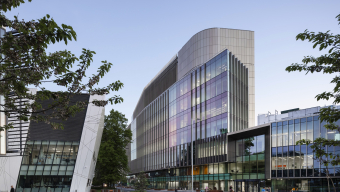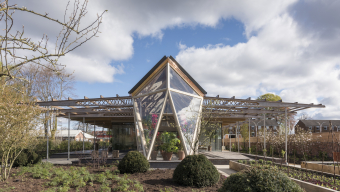This Study tour will take place on Monday 26 February, between 14.30–18.00, and will visit the Christie Paterson Cancer Research Centre in Manchester and Maggie’s at the Robert Parfett Building, Manchester. Learn more about the projects in the Programme.
If you are interested in participating on the tours, please e-mail info@europeanhealthcaredesign.eu. Bookings will be subject to a fee of £45 + VAT and availability of places, with preference given to NHS trusts in the event of tours being oversubscribed.
Christie Paterson Cancer Research Centre in Manchester

Designed by BDP for the Christie NHS Foundation Trust, the University of Manchester, and Cancer Research UK, the £150m Christie Paterson Cancer Research Centre includes laboratories, research spaces, and consultant workspace. At more than 25,000 sq m and ten storeys high, the new building is more than twice the size of the previous facility, which was severely damaged in a fire. It promises to transform organisational adjacencies through co-location of research groups and clinicians. It will be Manchester’s scientific headquarters for discovery science, as part of the International Alliance for Early Cancer Detection, housing more than 300 scientists, 400 clinicians, and operational staff. They will deliver clinical trials covering the full extent of the patient pathway, from prevention and novel treatments to living with and beyond cancer. With a focus on early detection and diagnosis of cancer, the new Cancer Research UK Biomarker Centre will also form a central component of the building.
Maggie’s at the Robert Parfett Building, Manchester

Designed by Sir Norman Foster of Foster + Partners, this Maggie’s centre opened in 2016 in the grounds of the Christie Hospital in Manchester. Set in a peaceful garden, the existing green spaces inspired the centre’s design, which draws on natural themes that engage the outdoors. The building is arranged over a single storey and the natural timber structure focuses around a wide, central spine, with the roof rising in the centre to create a mezzanine level beautifully illuminated with natural light. Exposed lightweight beams and timber lattice support the roof while also defining different areas in the open plan space. Smaller, private rooms are available along the side. An integrated glass house extends from the south of the building, providing a space for people to gather and enjoy the therapeutic qualities of nature and the outdoors while being sheltered from the elements. Group creative writing and art sessions are often held here, as well as providing a space for people to sit and talk with each other. The surrounding gardens have been designed by landscape designer Dan Pearson, combining a rich mix of spaces, from the working glass house to bright clusters of flowers and tranquil water features. Deep canopies shelter the centre’s open terraces from rain, allowing people to enjoy fresh air and the garden whatever the weather. Lord Foster said of the building: “This project has a particular personal significance, as I was born in the city and have first-hand experience of the distress of a cancer diagnosis. I believe in the power of architecture to lift the spirits and help in the process of therapy.”

